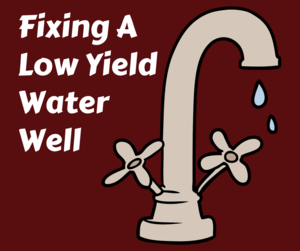CALL TODAY 1-800-441-6281
CALL TODAY 1-800-441-6281

What is Water Well Hydrofracking and How Does it Work
If you’ve seen the news recently you’re probably familiar with the term “fracking” as it’s related to oil exploration. A well-developed process that is less well known and talked about is hydrofracking, a process that can help homeowners to improve well water yield.
The hydrofracturing process involves injecting water, under extremely high pressure, into a bedrock formation via your well. The result is that it works to flush and remove small particles and rock fragments from existing bedrock fractures, clearing and increasing their size. This allows water to flow into the well at increased rates. It also produces a larger network of water-bearing fractures in the bedrock, which supplies the well with increased supply.
Hydrofracking is often used to increase well yields in new construction deep wells with low production rates. It can also be used in older wells where the production rate has slowed due to mineralization blocking water producing fractures.
The History Of "Fracking" Water Wells
Fracking was first developed in the oil fields as a means of increasing production and has been adapted by the drinking water well industry only recently. In a short time is has become the preferred method used by contractors for developing bedrock wells because it is a controllable process.
Previous methods included blasting with dynamite or the application of dry ice into capped wells, but these methods were uncontrollable and could sometimes backfire and result in complete well failure. Blasting often resulted in the well’s collapse rendering it useless. As a result, the CO2 method was developed.
The dry ice method is much less violent and actually works in much the same way as hydrofracking, but is a less controllable process. CO2 in the form of dry ice is introduced into the well, which is then sealed or “capped.” As the ice melts it releases the CO2 as a gas, which increases pressure expanding into any fissures in the bedrock and opening them up. This method often resulted in a 5% increase in production. However, there is a higher failure rate than with hydrofracking.
The Well Water Hydrofracking Process
The process involves placing two inflatable or mechanical packers at 40 and 60 feet below the surface to seal the well and prevent the introduction of surface contaminants. Water is then pumped through at pressures of up to 2000 to 3000 pounds per square inch. If successful, the internal pressure of the well will rise opening up any bedrock fissures to allow water to flow into the well at increased levels. The risk for contamination of the bedrock at such high psi levels means only potable or disinfected water is used.
For single household wells, a single packer system is often used and commonly produces results. Well yields generally are modestly improved, but in cases where the original well yield was very low, results can be significant. Typical well yields after hydrofracking will improve by .5 – 5 gallons per minute. Occasionally large increases are realized and well water contractors report a high success rate compared with earlier recovery methods.
Only licensed hydrofracking contractors are allowed to perform the procedure in New Hampshire. Skillings & Sons is one of the approved companies and our hydrofracking success rate is 98%. If you are thinking about having your well fracked, call us at 1 (800) 441-6281 to learn about our guarantee. Our well drilling professionals can analyze your situation and help you to determine if hydrofracking is right for you.

